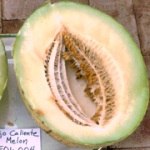However this got me thinking and doing some research. There are 19 Pueblos in New Mexico and each one has developed its own agriculture and varieties of vegetables which are obviously suited to the elevation, watering technique and specific growing conditions there. It seems that they had already done our work for us, all we needed was to procure some seed and grow them out.
Native Seed Search is an organization dedicated to preserving the agriculural heritage seeds of the Southwest. We chose 4 varieties to grow Corrales, Ojo Caliente, San Juan and Santa Domingo casaba. See catalog pictures below.
As is often the case, the descriptions don’t match the final result. NSS is better than most at providing accuracy and not glorifying a type. On 9/25/10 we picked the best example of each type and tested for size, productivity and mainly taste. I am listing the catalog description along with our description.
Corrales-A new growout of a 1993 collection from Corrales, NM. Typical oblong native melons with ribs and smooth skin. Dark green fruit turn yellow when ripe. Sweet and juicy. As you can see there is some variability in appearance at same date and age of fruit, not too bad. NOT sweet and juicy, at best bland and juicy but pretty consistent in size and vines look and grow well. We will not grow this one again
Ojo Caliente- Originally obtained from a farmer in northern New Mexico. the oval fruits are smooth-skinned and can weigh 5-7 pounds. Pale green flesh with a tinge of orange is sweet and juicy. Harvest ripe fruits when bright yellow and aromatic. This melon is not very productive and actually was extremely bitter. I have never tasted a melon like it, we had to rinse out our mouths several times it was so bad and it almost ended our melon tasting adventure. Definite NO GROW.
Santo Domingo Casaba- Originally collected in Santo Domingo Pueblo, this is a casaba-type melon. The skin is slightly wrinkled, the flesh is white to light green. Sweet and tasty. This melon was pretty productive and hardy with the fruits being much more consistent in size and appearance than the other types and very large seeds. Unfortunately it has a poor taste. Will not grow again
San Juan- A prolific honeydew-type with smooth, light green skin and light to deep lime-colored flesh. Vines are somewhat compact and desert hardy. Prolific no, compact and hardy yes. I notice their description says nothing about taste yet we rate it’s taste as OK, nothing special and no better than store bought ,maybe not as good. If you have a lot of space and want to experiment then this would be the one. However there are much better melons out there to enjoy.
In summary our opinion is not to waste time growing any of the Native melons. They are inconsistent and seemed to have been probably cross pollinated with squash. The hypothesis was good but the results were poor.





